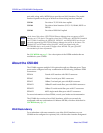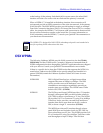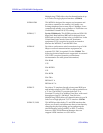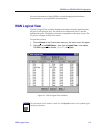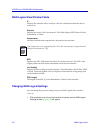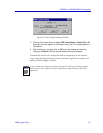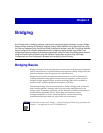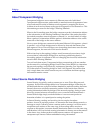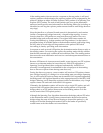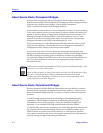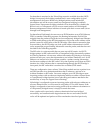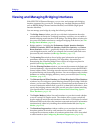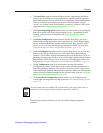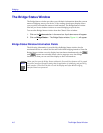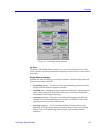
Bridging
4-2 Bridging Basics
About Transparent Bridging
Transparent bridges are most common in Ethernet networks. Individual
Transparent bridges monitor packet trafÞc on attached network segments to learn
where end stations reside in relation to each segment by mapping the Source
Address of each received frame to the port (and segment) it was detected on. This
information gets stored in the bridgeÕs Filtering Database.
When in the Forwarding state, the bridge compares a packetÕs destination address
to the information in the Filtering Database to determine if the packet should be
forwarded to another network segment or Þltered (i.e., not forwarded). A bridge
Þlters a packet if it determines that the packetÕs destination address exists on the
same side of the bridge as the source address.
If two or more bridges are connected to the same Ethernet LAN segmentÑplaced
in parallelÑonly a single bridge must be allowed to forward data frames onto
that segment. If two or more bridges were forwarding data frames onto the same
Ethernet segment, the network would soon be ßooded.
With a data loop in the topology, bridges would erroneously associate a single
source address with multiple bridge ports, and keep proliferating data by
forwarding packets in response to the ever-changing (but incorrect) information
stored in their Filtering Database.
To avoid such data storms, Transparent bridges communicate with one another
on the network by exchanging Bridge Protocol Data Units (BPDUs) to determine
the network topology and collectively implement a Spanning Tree Algorithm
(STA) that selects a controlling bridge for each LAN segment; this ensures that
only a single data route exists between any two end stations and that topology
information remains current.
About Source Route Bridging
Source Routing is typically used to connect two or more Token Ring network
segments. Source Route bridges differ from Transparent bridges in that they do
not build and then use a physical address database to make forwarding decisions.
Instead, the source end station transmits packets with a header that contains
routing information (added by bridges in the network topology during a route
discovery process between end stations); once a route has been determined, a
Source Route bridge simply reads the header of a source routed packet to
determine whether it is a participant in routing the packet.
In Source Routing, sending and receiving devices employ broadcast
packetsÑknown as explorer packetsÑto determine the most efÞcient route for a
message to travel. Generally, before a station sends a message, it will Þrst send a
test packet to all stations on the same ring; if the sending station receives a
response to this packet, it assumes that the destination station is on the same ring
and therefore it will not include routing information in frames sent to that station
in the future. Any further packets issued between stations will appear to be
transparent-style frames without embedded routing information.



